Angkor’s architectural marvels stand as testaments to Cambodia’s rich cultural heritage and artistic prowess. Among these, Angkor Wat emerges as the largest religious monument globally, showcasing intricate bas-reliefs that narrate ancient stories. The Bayon Temple captivates with its enigmatic stone faces, while Ta Prohm enchants with its seamless blend of nature and ruins. As visitors explore the Elephant Terrace and the Terrace of the Leper King, they uncover the grandeur of Khmer artistry. Yet, there’s so much more to these sites than meets the eye, inviting a closer look into their fascinating histories and hidden meanings.
Good To Know
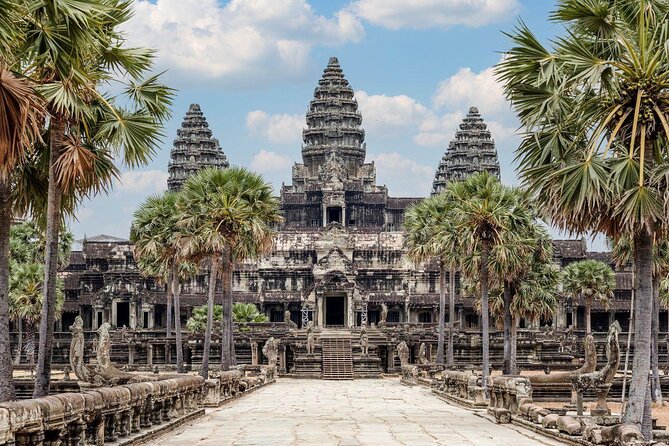
- Angkor Wat: The largest religious monument globally, originally a Hindu temple dedicated to Vishnu, showcasing intricate carvings and massive architecture.
- Bayon Temple: Famous for over 200 smiling stone faces, this 12th-century temple features detailed bas-reliefs depicting historical events and daily life.
- Ta Prohm: Known for its mystical atmosphere, this 12th-century temple intertwines with towering trees, creating a unique fusion of nature and architecture.
- Elephant Terrace: A 300-meter-long structure adorned with impressive stonework that illustrates elephants, representing strength, and was used for royal ceremonies.
- Terrace of the Leper King: Features intricate carvings of mythological figures and daily life, providing stunning views of Angkor Thom and historical significance.
Historical Significance of Angkor

Angkor stands as a testament to the grandeur of the Khmer Empire, which flourished from the 9th to the 15th centuries. This remarkable complex reflects the empire’s artistic, architectural, and engineering achievements.
The temples, particularly Angkor Wat, showcase intricate carvings and massive stone constructions, illustrating the Khmer’s devotion to their religion and the divine. Beyond aesthetics, Angkor served as a political and cultural hub, influencing trade and governance throughout Southeast Asia.
Its extensive irrigation system supported agricultural prosperity, enabling the empire’s growth. Despite the decline of the Khmer Empire, Angkor’s historical significance endures, drawing scholars and travelers alike.
Today, it remains a symbol of Cambodia’s rich heritage and resilience, highlighting a civilization that once thrived in the heart of Southeast Asia.
You can also read our reviews of more tours and experiences in Siem Reap.
Overview of Angkor Wat
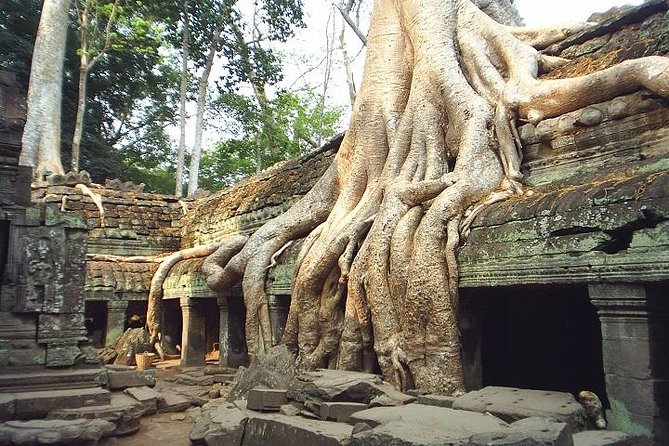
The majestic silhouette of Angkor Wat rises against the Cambodian skyline, captivating visitors with its intricate design and historical significance.
As the largest religious monument in the world, it reflects the zenith of Khmer architecture and artistry. Built in the early 12th century, Angkor Wat originally served as a Hindu temple dedicated to Vishnu before transforming into a Buddhist site.
Visitors often marvel at its unique layout, bas-reliefs, and towering spires, which symbolize Mount Meru, the center of the universe in Hindu cosmology.
- UNESCO World Heritage Site
- Encompasses 162.6 hectares
- Features extensive bas-reliefs depicting Hindu epics
- Draws millions of travelers annually
Angkor Wat remains a testament to Cambodia’s rich cultural heritage.
Bayon Temple Highlights
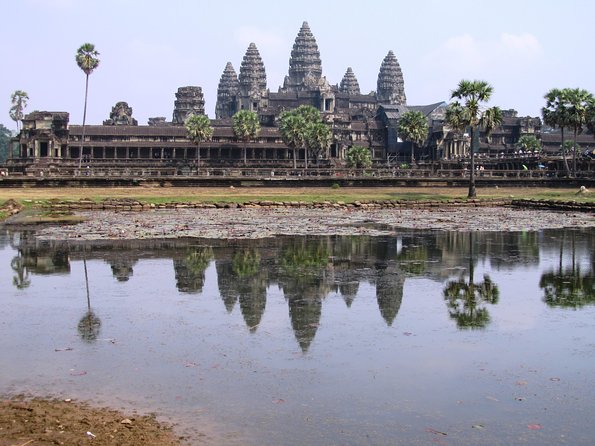
Nestled within the ancient city of Angkor Thom, Bayon Temple captivates visitors with its enigmatic charm and remarkable artistry.
Constructed in the late 12th century, this temple showcases the ingenuity of Khmer architecture, featuring over 200 serene and smiling stone faces that seem to observe every visitor. Each face is believed to represent Avalokiteshvara, the bodhisattva of compassion.
The intricate bas-reliefs that adorn the temple walls depict historical events and daily life, offering insights into the Khmer Empire’s culture. As guests wander through the temple’s maze-like corridors, they’re enveloped by a sense of wonder.
Bayon Temple stands as a testament to Cambodia’s rich history and artistic heritage, making it a must-see on any Angkor Wat tour.
Exploring Ta Prohm
How does one capture the enchanting essence of Ta Prohm? This 12th-century temple, dedicated to Jayavarman VII’s mother, seamlessly integrates with its jungle surroundings, showcasing nature’s reclamation.
Towering trees entwine with ancient stones, creating a mystical atmosphere that captivates visitors. Walking through its intricately carved ruins, one can’t help but feel transported back in time.
To enhance your exploration of Ta Prohm, consider these highlights:
- Marvel at the massive tree roots enveloping temple walls.
- Discover the detailed stone carvings depicting celestial beings.
- Experience the serene ambiance, perfect for reflection.
- Capture stunning photographs of this unique fusion of architecture and nature.
Exploring Ta Prohm offers a glimpse into the extraordinary resilience of nature and history.
Elephant Terrace Features
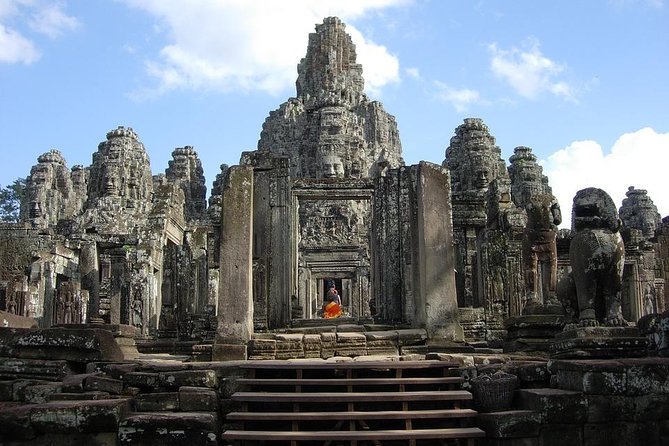
With its impressive stonework and intricate carvings, the Elephant Terrace stands as a testament to the grandeur of the Khmer Empire. This architectural marvel, originally used for royal ceremonies, features stunning bas-reliefs of elephants, symbolizing strength and loyalty. Visitors marvel at the detailed sculptures that depict scenes of daily life and mythical creatures, showcasing the artistry of the time.
| Feature | Description | Significance |
|---|---|---|
| Bas-reliefs | Carvings of elephants and scenes | Reflects Khmer artistry |
| Length | Approximately 300 meters | A grand ceremonial space |
| Historical Context | Built in the late 12th century | Highlights royal heritage |
The Elephant Terrace remains a highlight of the Angkor complex, drawing visitors from around the world.
Terrace of the Leper King
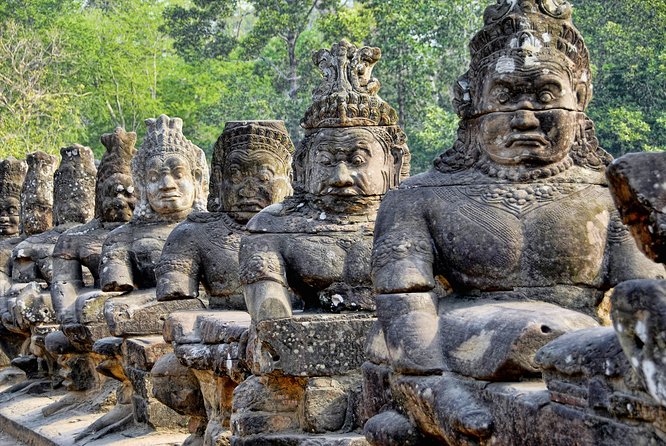
The Terrace of the Leper King captivates visitors with its intricate carvings and rich historical significance, serving as a remarkable example of Khmer artistry.
This impressive structure features detailed depictions of mythological figures, including divine beings and scenes of daily life. Scholars believe the terrace may have served as a royal platform for ceremonies or as a memorial to a king afflicted by leprosy.
Its unique name, derived from a 19th-century statue resembling a leper, adds to its intrigue.
- Explore the detailed bas-reliefs that adorn the terrace.
- Discover its connection to ancient Khmer rituals.
- Learn about the significance of the surrounding architecture.
- Appreciate the stunning views of Angkor Thom from the terrace.
Visitor Experience Tips
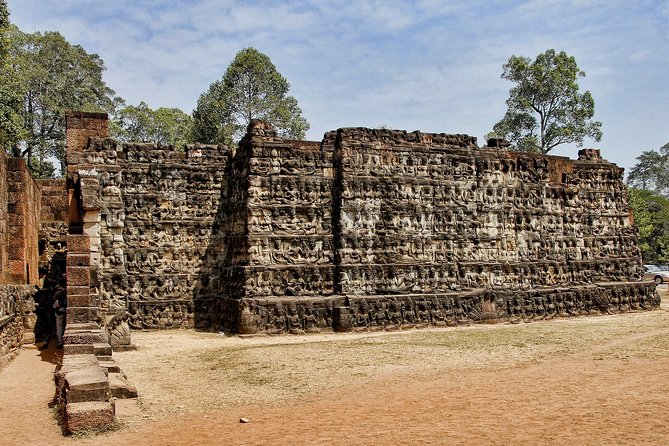
Before embarking on the Angkor Wat tour, visitors should equip themselves with a few essential tips to enhance their experience.
First, they should dress appropriately; clothing must cover shoulders and knees to gain entry to sacred sites.
It’s wise to bring plenty of water and snacks, as exploring the vast temple complex can be exhausting.
A good camera or smartphone is essential, as the stunning architecture and landscapes deserve to be captured.
Visitors should also consider starting early in the day to avoid crowds and the heat.
Lastly, hiring a knowledgeable guide can provide valuable historical context, making the experience more enriching.
With these tips, visitors can fully appreciate the beauty and significance of Angkor Wat.
Must-See Temples
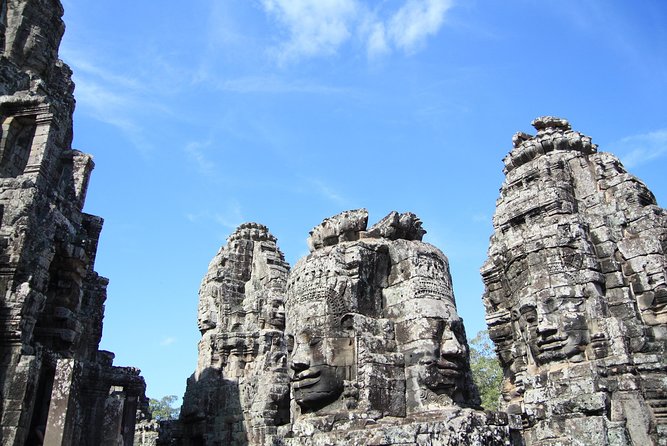
Exploring Angkor Wat’s vast expanse reveals a treasure trove of architectural marvels, each temple telling its own unique story.
Visitors shouldn’t miss these must-see temples that showcase the grandeur of the Khmer Empire:
-
Bayon Temple: Famous for its smiling stone faces, this temple is a marvel of 12th-century architecture.
-
Ta Prohm: Known for its enchanting blend with nature, this temple features trees growing through its ruins.
-
Angkor Thom: The last capital of the Khmer Empire, filled with stunning terraces and gateways.
-
Banteay Srei: A smaller temple renowned for its intricate pink sandstone carvings and exquisite details.
Each site offers a glimpse into Cambodia’s rich history, making them essential stops on any Angkor adventure.
Frequently Asked Questions
What Is the Best Time to Visit Angkor Wat?
The best time to visit Angkor Wat is during the dry season, from November to February. The weather’s cooler, making exploration pleasant, and it’s easier to appreciate the majestic temples without the crowds of peak tourism.
Are There Any Entry Fees for Angkor Wat?
Visitors should expect an entry fee for Angkor Wat, which typically includes a one-day pass to the entire archaeological site. It’s crucial to check current rates, as they can change over time.
Can I Take Photos Inside the Temples?
Visitors can take photos inside the temples, but they’re encouraged to be respectful of the sacred environment. Flash photography is often discouraged to preserve the artistry and integrity of these ancient structures.
Are Food and Drinks Available at the Site?
At the site, food and drinks aren’t readily available, so visitors should plan ahead. Many choose to bring snacks and water, ensuring they stay energized while exploring the incredible temples throughout the day.
What Should I Bring for a Day Tour?
For a day tour, she should bring water, sunscreen, a hat, and comfortable walking shoes. A light jacket can be handy for cooler moments, while a small bag will keep her essentials organized.
The Sum Up
To sum it up, Angkor’s architectural wonders offer a glimpse into Cambodia’s rich history and cultural heritage. From the awe-inspiring Angkor Wat to the enigmatic faces of the Bayon Temple, each site tells a unique story. Visitors are enchanted by Ta Prohm’s blend of nature and ruins, while the Elephant Terrace and Terrace of the Leper King showcase exquisite artistry. Exploring these remarkable temples not only reveals the grandeur of the Khmer Empire but also leaves lasting memories for all who visit.
More Tour Reviews in Siem Reap
- Siem Reap: 8-Hour Forgotten Treasures Motorbike Tour
- Siem Reap: Kulen Mountain, Beng Melea, and Kampong Phluk
- Siem Reap: Temples & Kulen Mountain Tour 3-Day Tour
- From Siem Reap: Beng Mealea and Koh Ker Temple Day Trip
- Siem Reap: Phnom Bok Mountain and Grand Circle Temples Tour
- Siem Reap: Apsara Dance Show with Buffet Dinner & Tuk-Tuk…
Not for you? Here's more nearby things to do in Siem Reap we have reviewed
- Siem Reap: 8-Hour Forgotten Treasures Motorbike Tour
- Siem Reap: Kulen Mountain, Beng Melea, and Kampong Phluk
- Siem Reap: Temples & Kulen Mountain Tour 3-Day Tour
- From Siem Reap: Beng Mealea and Koh Ker Temple Day Trip
- Siem Reap: Phnom Bok Mountain and Grand Circle Temples Tour
- Siem Reap: Apsara Dance Show with Buffet Dinner & Tuk-Tuk…
- Siem Reap Lotus Silk Farm Tour with Pick Up downtown
- Siem Reap: 2-Days Angkor Wat with Sunrise Small-Group Tour
- Siem Reap: FREE Market & Local Temple Tour
- Siem Reap: 3-Day Guided Tour with Angkor Wat Sunrise
- Siem Reap: 1-Day Group Tour of Angkor in Spanish with Expert Tour Guide
- From Siem Reap: Banteay Srei and Kulen Waterfall Guided Tour
